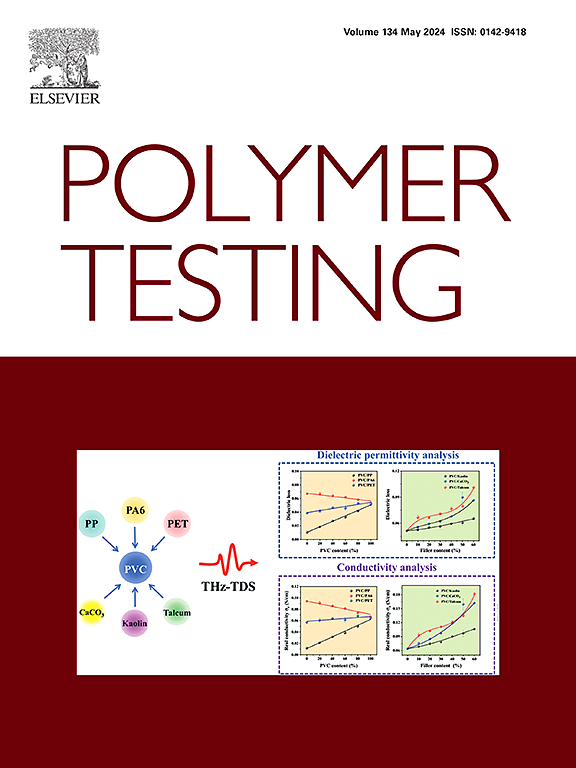A highly transparent and self-healing elastomer based on dynamically reversible heterocyclic interactions with enhanced toughness and outstanding rolling reliability
IF 6
2区 材料科学
Q1 MATERIALS SCIENCE, CHARACTERIZATION & TESTING
引用次数: 0
Abstract
A highly flexible elastomer for rollable displays was developed through the incorporation of reversible heterocyclic interactions. Functional heterocyclic pendant moieties were integrated into the polymeric chains within a conventional elastomer, facilitating dynamically reversible internal interactions via intensified hydrogen bonding. This approach significantly enhanced the performance of the resulting elastomer by optimizing its internal network structure. It exhibited excellent optical properties, including visible light transmittance over 91 %, a yellow index below 2, a haze under 1 %, and substantial thermal stability. Moreover, it effectively addressed the traditional trade-off between mechanical and self-healing properties in typical self-healing materials. It also achieved rapid and complete self-healing and a toughness value four times greater than a reference elastomer lacking heterocyclic groups. Notably, the developed elastomer exhibited outstanding durability, enduring over 10,000 rolling and unrolling cycles without mechanical failure, which underscores its superior rolling reliability. These properties are attributed to a unique internal network structure reinforced by reversible and intensified hydrogen bonding within the matrix. To provide further insights into enhanced mechanical strength, self-healing performance, and rolling reliability, a mechanism was proposed and analyzed using both small molecular and polymeric model systems. This analysis highlights the critical role of the heterocyclic interactions in forming a robust yet dynamically adaptable network.
基于动态可逆杂环相互作用的高透明度自愈合弹性体,具有更强的韧性和出色的轧制可靠性
通过结合可逆杂环相互作用,开发了一种用于可卷曲显示器的高柔性弹性体。功能性杂环悬垂部分被整合到传统弹性体的聚合物链中,通过强化氢键促进动态可逆的内部相互作用。该方法通过优化弹性体的内部网络结构,显著提高了弹性体的性能。它具有优异的光学性能,可见光透过率超过91%,黄指数低于2,雾度低于1%,热稳定性好。此外,它有效地解决了典型自修复材料中机械性能和自修复性能之间的传统权衡。它还实现了快速和完全的自愈,韧性值比不含杂环基团的参考弹性体高4倍。值得注意的是,所开发的弹性体具有出色的耐久性,可承受超过10,000次的滚动和展开循环而无机械故障,这凸显了其优越的滚动可靠性。这些性能归因于独特的内部网络结构,由可逆和增强的氢键在基体内增强。为了进一步了解增强的机械强度、自愈性能和滚动可靠性,研究人员提出了一种机制,并使用小分子和聚合物模型系统进行了分析。这一分析强调了杂环相互作用在形成一个鲁棒且动态适应的网络中的关键作用。
本文章由计算机程序翻译,如有差异,请以英文原文为准。
求助全文
约1分钟内获得全文
求助全文
来源期刊

Polymer Testing
工程技术-材料科学:表征与测试
CiteScore
10.70
自引率
5.90%
发文量
328
审稿时长
44 days
期刊介绍:
Polymer Testing focuses on the testing, analysis and characterization of polymer materials, including both synthetic and natural or biobased polymers. Novel testing methods and the testing of novel polymeric materials in bulk, solution and dispersion is covered. In addition, we welcome the submission of the testing of polymeric materials for a wide range of applications and industrial products as well as nanoscale characterization.
The scope includes but is not limited to the following main topics:
Novel testing methods and Chemical analysis
• mechanical, thermal, electrical, chemical, imaging, spectroscopy, scattering and rheology
Physical properties and behaviour of novel polymer systems
• nanoscale properties, morphology, transport properties
Degradation and recycling of polymeric materials when combined with novel testing or characterization methods
• degradation, biodegradation, ageing and fire retardancy
Modelling and Simulation work will be only considered when it is linked to new or previously published experimental results.
 求助内容:
求助内容: 应助结果提醒方式:
应助结果提醒方式:


